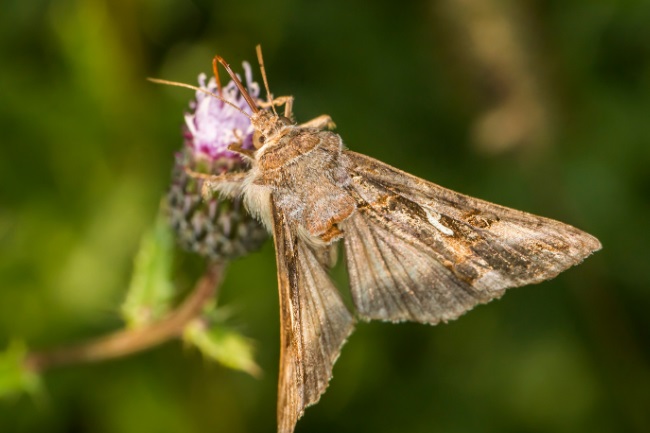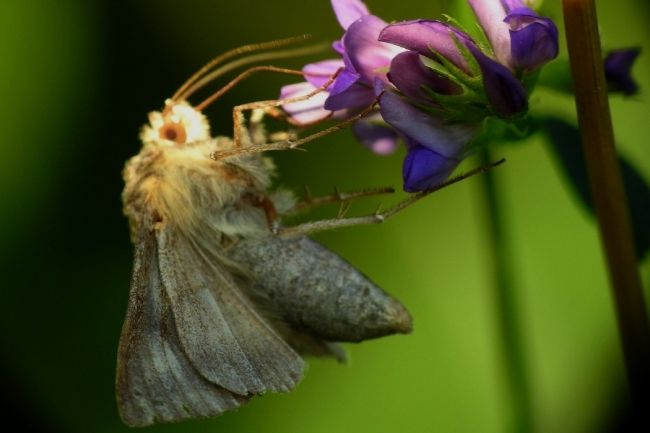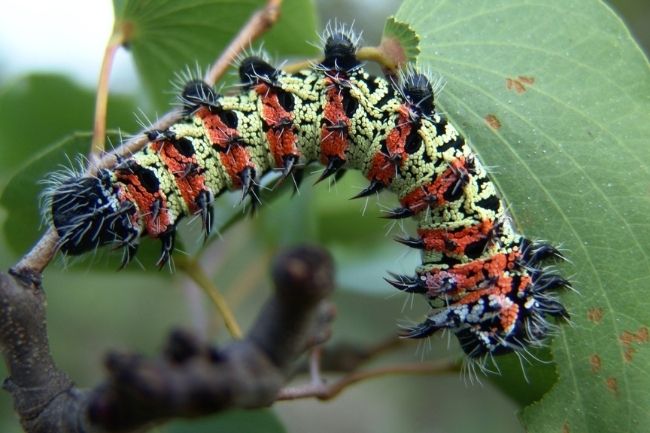Adult moths largely don’t eat, instead drinking their supper through their long proboscis. The vast majority of adult moths feed on nectar, however, there are a number of species that consume other liquids such as fruit juices and even blood. In their larval form they eat mostly leafy material, but some are carnivorous, eating other insects instead.
Contents
How do moths eat and drink?

While we may think of moths as completely separate from the more beloved butterflies, the two groups are often difficult to separate from one another.
Like butterflies, moths undergo complete metamorphosis, starting life as a caterpillar and ending it as an adult moth. Like butterfly caterpillars, a moth caterpillar is a moving stomach, trying to eat as much as possible in a relatively short period of time.
The more they eat the stronger and more glorious they will become as adults. Strong adults are more likely to survive to mate, and more likely to be chosen by the opposite sex.
| Feeding Type | Description |
|---|---|
| Nectar Feeders | Moths that primarily feed on the nectar of flowers |
| Fruit Feeders | Moths that feed on ripe fruits or fruit juices |
| Sap Feeders | Moths that extract sap from plants or trees |
| Pollen Feeders | Moths that consume pollen grains from flowers |
| Carrion Feeders | Moths that feed on decaying organic matter or carrion |
| Larval Feeders | Moths that feed on plant leaves or other organic matter |
Therefore when talking about how and what moths eat, we have both the caterpillar’s and the adult’s appetite to consider.
Caterpillars spend most of their time eating vegetation. This means there’s a great deal of ripping and chewing to be done in order to get the goodness they need out of their food. In order to get on with all the eating they need to do they have a mouth located on their head.
The mouth is made up of two very strong mandibles, with sharp edges to help tear up their food into easier to consume chunks. A set of maxillae sit behind these and are like lips guiding the food into the mouth.
Caterpillars have several moults, stages where their exoskeleton is shed to allow them to increase in size. Once these moults are completed they then become a pupa or chrysalis, a stage where their cells break down to a kind of soup and rearrange into their adult form.

For adult moths their diet is made up more of liquid foods, meaning they don’t have the need for the tearing and chopping implements. While many do still have a set of mandibles they are usually non-functioning.
Instead, what adult moths have is a long tube known as proboscis. While we may think of this as one complete tube, it is actually formed by several interconnected maxillary galeae.
The proboscis spends most of its time curled up underneath the head of the moth, this being its natural structural form. Fluid pressure is used to unfurl it so it can be used to suck up liquids such as nectar.
Interestingly there are a few moth species that still have working mandibles, such as moths within the Micropterigidae. These use their mouthparts to munch down on tasty protein-rich pollen.
| Drinking Behavior | Description |
|---|---|
| Sipping | Moths that delicately sip fluids, such as nectar or sap |
| Lapping | Moths that use their proboscis to lap up liquid |
| Imbibing | Moths that absorb liquids by pressing their mouthparts on surfaces |
| Droplet Drinking | Moths that collect droplets of water or dew for hydration |
| Capillary Action | Moths that use capillary action to draw up liquid |
Even more unusual, some adult moths don’t have any way to eat at all, getting all their nutrition as a caterpillar and then concentrating on reproduction as an adult. These moth species tend not to live long as adults, as their energy is quickly exhausted.
The most bizarre moth diet is perhaps that of a group of moths often referred to as vampire moths. Species such as Calyptra bicolor have adapted mouthparts, which they use to pierce skin of cattle and even sometimes humans, drinking their blood.
Some species have less grisly tastes however, using their proboscis to pierce the skin of fruit instead.
Other odd caterpillar foods can include fur and natural clothing fibres. The clothes moth is famous for destroying wardrobes, though the adult moth is not at fault.
Also read: What Caterpillar Eats Parsley? (List of Species)
Do moths eat nectar?
Just like butterflies one of the main sources of food for adult moths is the nectar they sip from flowers with their long proboscis.
Because of this habit moths are just as important pollinators as butterflies. In fact in many cases they are more important than butterflies, as there are more of them, and they pollinate many night flowering plants that butterflies cannot pollinate as they are active in the day.
Flowers that look to attract moths are often very pale in colour, particularly white. This colour catches the light well at night, making them more obvious. They may also have strong fragrances to let moths know where they are.
Many flowers also adjust their design so only particular species can feed on them, such as those with longer proboscis. This makes it more likely those moths will help to another flower of the same species, increasing the likelihood of cross pollination.
Also read: Easy DIY Hummingbird Nectar with FAQ
Do moths eat flowers?

As adult moths these insects do not have the mouthparts to feed on flowers. The only exception is those adult moths that still having working mandibles, however, these focus on the protein-rich pollen, rather than the flower itself.
When it comes to the caterpillars of moths however, flowers and other plant matter are their main food. Some caterpillars will eat almost any plant they come into contact with, whilst others will focus only on one plant or group of plants.
Caterpillars tend to focus on the leafy parts of the plant, but will often also munch down on the flowers themselves.
Do moths eat grass?
We have a tendency to think that only planting flowers can help boost pollinators populations, however, many caterpillars of both butterflies and moths rely on various native grasses. Like with other plants the caterpillars will merrily munch away on grass leaves until they turn into their adult form.
Adult moths, however, cannot feed on grasses. While grasses do have flowers, and do produce pollen, it is usually designed to be spread by the wind. As they rely on wind pollination rather than insects, grasses don’t produce nectar, as a bribe to attract pollinators. This means there’s nothing for adult moths to feed on.
Do moths eat fruit?
As with other parts of a plant, fruit is rather too solid for adult moths to eat. The one exception is rotted fruit or fruit juices, which some moths may drink from to substitute their diets, particularly at times of year when nectar is less available.
In their larval stage many moth caterpillars will eat fruit of the plants they are feeding on.
Do moths eat other bugs?
There are many carnivorous caterpillars in the world. Several species have been observed in Hawaii. These caterpillars have specially adapted legs that are spikey and needle-like. They can then use these legs like claws to grab at and pierce their prey.
Another way in which caterpillars may eat other bugs is by consuming insect larvae or eggs, or those attached to plant vegetation, such as sap suckers like scale insects.
Do moths eat spiders?
Moths do not generally eat spiders, some of the carnivorous moth caterpillars may eat smaller spiders if they get a chance. However spiders will often be too fast moving for them to have much of a chance. Additionally, many spiders will feed on caterpillars, therefore it can be risk for caterpillars to try and turn the tables.
Do moths eat mosquitoes?
Like spiders, mosquitos are a little bit too speedy for most caterpillars to have a chance to catch them. Adults too would not be able to eat these insects.
What does a hawk moth eat?
There are a number of different hawk moth species across the world. They get their names from their ability to hover in place like a hawk.
Their appetites vary somewhat in the species of plants they feed on, but as with most moth species the caterpillars are herbivores, while the adults feed on nectar. The elephant hawkmoth caterpillar, for example, feeds on willowherb species as well as bedstraws, while the adult drinks nectar from a range of plants including honeysuckle.
What does a sphinx moth eat?
Sphinx moths are another name for the hawk moth family. There are around 1,500 species across the world, well beloved for their large wings and interesting patterns and colours.
What does a hummingbird moth eat?
The hummingbird hawkmoth is a species of the hawk moth family. It is so named as its shape and flight pattern have led many people to mistake it for a hummingbird, though it is found in many countries where hummingbirds don’t live.
The adults drink nectar from a wide range of species including buddleia and lavender. The larvae feed on bedstraw and wild madder in particular.
What does a gypsy moth eat?
The gypsy moth is seen as a serious pest species in many countries, due to its ability to defoliate deciduous trees. It has a preference for oaks but can be found on a range of trees and shrubs.
The adults by comparison do not feed at all, though they may drink up some moisture. Because they are not able to feed they do not live long, simply aiming to mate and then succumbing to exhaustion.
What does a tiger moth eat?
The garden tiger moth is a brightly coloured species with forewings of striking black and white, and startling red beneath. The moth’s eye-catching design is to warn predators of its poisonous content.
The caterpillar eats a wide range of plant species, but particularly chooses to feed on toxic species such as foxglove, so it can accumulate it’s toxins in its body.
The adult is also a generalist, feeding on nectar from a wide range if flowers.
What does a silk moth eat?
Silk moths are known best for their ability to produce silk. Centuries of selective breeding has resulted in there being a marked difference between wild and domesticated silk moths.
Caterpillars of both species feed on white numbers leaves. Adults do not feed.
What does a luna moth eat?
Luna moths are large stunning moths from the silkworm family. They are found across much of America from Texas to Canada. Their stunning wings can be either pale green or yellow. The caterpillars are herbivores, eating the leaves of various trees, such as white birch and hickory. The adults, by contrast, do not eat at all.
What does a polyphemus moth eat?
Though largely brown in colour, the adult polyphemus is still a stunning moth to behold, with its large patterned wings.
A member of the giant silkworm family the caterpillar feeds on a range of deciduous trees, particularly American elm and willow. The adult does not feed, and therefore does not live long, mating quickly and dying soon afterwards.
Hungry caterpillars and thirsty moths

Caterpillars are eating machines, trying to consume as much as possible in a short period of time. Food is energy and energy helps them to grow up big and strong.
Adult moths on the other hand are fully grown and simply looking to keep powering themselves on till they can mate.
Beyond their own appetites both stages are an important part of the food chain, helping to feed a wide range of predators, from birds to reptiles, even to bears.
So while we may not be too happy to see the bite marks on our favourite plant, and certainly won’t enjoy being bitten by a vampire moth, it’s important to remember what a valuable group of insects moths are, and how they contribute to the smooth running of our world.

